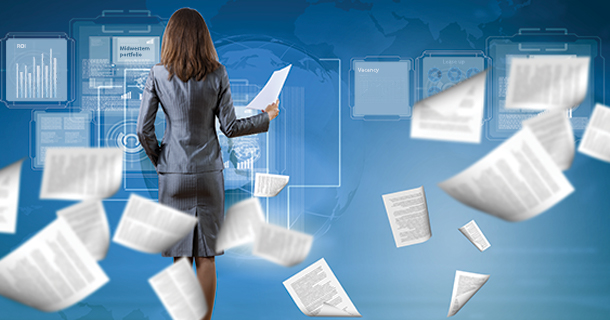Take a moment and gaze upon this page as if it were just a blank piece of paper.
A single, blank sheet of paper. What potential it holds. What an awesome technology paper is, this blank paper page that you are now imagining. What could be written upon its yet open space? What will it be transformed into? Perhaps a message? A request? A contract? A business order? Facts discovered from research? Medical test results? A job offer? A declaration of political principle? A license? A set of life goals? An expression of a belief?
There are reasons why we need and, yes, even love our paper. Those reasons are real and meaningful. There is something that happens when we write things down. The transaction is more tangible when we hand someone a letter or a document. Doing so, not only memorializes a personal or business event or activity, it creates a place and a moment that we can forever refer to, a way to learn or communicate something new, a way to express ourselves. It is with and on paper that we store and organize our legacy and bind our history.
The positive attributes of paper are not about to be forsaken to a digital abyss any time soon, which is why paper has won the battle to go paperless.
This is not to say that we cannot become smarter about how and when we need and use paper in a digital state. It is to say, that digital document management systems are best served by embracing the realities that people, managers, courts and business partners love the paper.
Going paperless is a mantra that has been preached for years. Fact is, paper isn’t going anywhere, anytime soon. Since 1999 more than 125,000,000 printers have been purchased and the use of paper has grown over 400x in the last four decades.
For many real reasons we need and love our paper. The use of paper represents one of the most prevalent areas of wasted business expense dollars. Waste is to be found in the paper we print, use, copy, file, ship and process. Today’s digital document capture and storage systems are ready to go when it comes to reducing expense surrounding the paper we use and handle. Such systems allow you to use and have paper when and where you need actual paper, and use electronic versions of documents when and where you can save money.
Paper has been around since 2000 BC. It has proven itself to be one of the most enduring inventions ever created by man. Paper rivals the invention of the wheel, in my opinion.
Its power is daunting. Its flexibility and adaptability is astounding. Its mobility is unique. What a piece of paper can archive, store and convey can be life changing. The comfort and solace of a single piece of paper can serve as the foundation for empires, lives and nations. Think of the great paper documents that record mankind’s history.
Technology has not yet reached into the realms so strongly possessed today by paper. For technology to replace paper means more than static digital images and replicas. The way we use of paper is an entrenched dimension of the human experience.
Paper is a basis for connectivity when or where technology doesn’t or can’t. Certainly, paper is less painful to install, debug and use and it doesn’t need a battery.
Experience teaches that a one size fits all solution for reducing paper costs just isn’t true. Property management companies have different needs than field service inspection companies, law firms, auditors or retail businesses, for example.
Since we know that paper isn’t going away anytime soon, becoming digitally adept in your use of paper can reduce costs and improve business performance. It is now within the reach of every business to gain control over all those stacks of paper, eliminate filing cabinets and improve business profitability.
The truth is that while saving money around the paper you use and the paper files you manage is important, what you will come to discover is that the operational benefits are dramatic for you and your residents and business partners. In most businesses 40 percent of staff time is spent handling paper. What would the benefit to your business if you were able to expand available staff time by 25 percent?
In their landmark book the Myth of the Paperless Office researchers and authors Sellen and Harper describe the tenants and attributes of paper that cause its continued use to be almost unassailable.
The use of paper is entwined into the DNA of how we think, how we work, how we organize ourselves, how we make decisions, how we discover how we learn, how we communicate. These subtleties compile a significant list that defines the why of paper. My takeaway is simple.
To eliminate paper is to take on the challenge of re-engineering thousands of years of human kind’s inculcated mores and methods that have become the fiber of what we do and how we do it.
When all the elements are considered together paper wins.
It is not about the technology of going paperless it is about understanding that paper is critical to achieving goals and central to the action elements of an effective business process. Going paperless should be re-defined to mean to have and use paper when and where you want it or need it and using digital versions of documents to advance workflows, enhance communications, collaborate and to store (file) less of it as paper when you are done with it.
In a world increasingly populated with knowledge workers, what drives the continued use of paper is the way we learn, work, understand, and communicate. What the right technology should do is leverage the best of paper.
Paper has won the battle against going totally paperless.
Author: Mike Radice is a member of the SyndicIT Services Technology Board and author of the Multifamily Technology Solutions blog.














